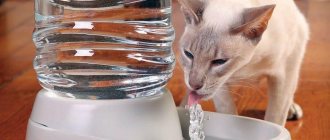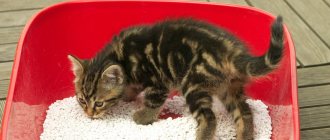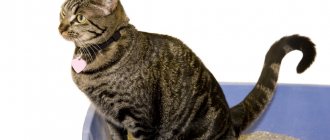Normal frequency of urination in cats
Kids go to the litter box several times a day, adult cats once, males - 1-2. There is no need to worry about going to the toilet more than twice as long as your pets are feeling well. It’s not a problem when cats double the number of trips during estrus, and neuters are emptied 6 times a day.
It is worse when there is urinary retention. If no traces of urine are found on the tray for more than two days, then the cat has anuria - a terrible symptom that can lead to overflow and rupture of the bladder and the death of the animal.
Causes and symptoms
It is quite difficult to calculate uniform norms for urination in a cat. This parameter depends on a variety of factors. Doctors can only give an average figure: a cat needs to go to the litter box 2-3 times a day. If the cat peed only once a day, you should pay extra attention. The fact is that animal urine is quite toxic, and, accumulating in the body, it can cause urolithiasis.
© shutterstock
So why hasn't the cat written for a day (or more)? There can be many reasons. Pets may experience such problems under the following conditions :
- recent stress;
- problems of the urethra;
- kidney diseases;
- insufficient fluid intake;
- exhaustion of the body;
- an untidy tray or unsuitable filler, and so on.
Also, a disease in which the cat pees little is accompanied by some symptoms. Lack of urination for more than a day can occur in parallel with the following symptoms :
- weakness and changes in the cat’s behavior;
- increased or decreased interest in liquids and food;
- increased irritability and so on.
As you can see, there can be many reasons and symptoms: from reluctance to drink to serious organ diseases. What should I do?
Symptoms of urinary retention in cats
Signs of urinary retention may not be immediately noticeable. When your pet feels discomfort, changes in his behavior will become noticeable.
Suspicion of urinary retention arises when the following symptoms are detected:
- frequent urges (pollakiuria) end in vain: the animal spins, fusses, but nothing comes of it;
- strangury occurs - painful urination, accompanied by a plaintive meow;
- blood appears in the urine (hematuria);
- the pet constantly licks the genitals;
- the cat does not play and becomes aggressive;
- if urine (urine) is released, it is drop by drop, with blood, pus and a pungent odor;
- when trying to pick up or touch the stomach, the pet growls and scratches;
- vomiting occurs;
- the cat stops drinking;
- convulsions develop.
Be sure to read:
Black feces in a cat: normal or pathological, when is it a dangerous symptom, diagnosis, how to treat
How and how to help an animal
If a cat refuses food and water, then the first thing to do is take your pet to a veterinarian. It is not possible to make a diagnosis on your own at home, so you need to call a doctor at home or take your pet to the clinic.
If it is impossible to get to the veterinarian in the next 24 hours, then you need to provide the cat with rest. To do this, you should prepare a clean litter; it should not be too soft or too hard. If an animal is hiding, you should not force it out of its hiding place. You can only place a bowl of food and fresh water nearby.
Bowls of water and food should always be available to the animal.
If the doctor has determined the cause, then you should follow the specialist’s recommendations and give medications according to instructions in the required dosages. This must be done calmly; you must not cause pain to the animal. Before giving medication, the cat needs to be stroked, and the tone of voice should be calm. This way, the pet will tolerate the treatment better, will not resist too much and will recover faster.
Additional recommendations:
- If the cause is stress, then the cat should be left alone for a while. It is advisable to call her to eat in a gentle tone. A calm and quiet environment, the absence of extraneous noise and periodic stroking will help you recover from stress.
- If your pet doesn't like the food, you need to replace it as soon as possible. It is recommended to give preference to balanced foods rather than cheap options containing a lot of harmful additives.
- In case of gastrointestinal upset and poisoning, you can give the animal activated charcoal (500 mg per 1 kg of weight). In this case, the tablet must be crushed and dissolved in 1 tsp. water. It is most convenient to give medicine using a syringe without a needle. It is enough to do this procedure once before seeing a doctor.
- Ticks and fleas are eliminated using special antiparasitic medications. You should not use them on your own; you should first consult your doctor. However, if this is not possible in the near future, and the animal has fleas or a tick is found, you can purchase Bars or Celandine shampoo.
- If the cause is helminthic infestations, then treatment is carried out with the help of anthelmintic drugs. The medication should be given only according to the regimen recommended by the doctor. Otherwise, larvae may remain, which will provoke a relapse.
- To alleviate the condition of an animal with gum inflammation, you can use a solution of Miramistin or potassium permanganate. It is necessary to treat the gums using a cotton pad and the selected product. This needs to be done 2 times a day. Do not press on problem areas.
A weak solution of potassium permanganate can be used to treat inflamed gums
What to do if your pet doesn’t eat, doesn’t drink and constantly sleeps
If an animal does not eat or drink, and also sleeps constantly, then this is an alarming signal of serious health problems. However, in extremely rare cases this is associated with stress. In this case, the pet should be left alone and allowed to rest. There is no danger in inactivity after stress. If the animal is lethargic, does not eat or drink for another reason, then postponing a visit to the doctor is dangerous, since with a serious pathology the cat may die.
Some recommendations that will help you hold out until the doctor arrives:
- It is necessary to ensure that fresh air enters the room.
- Do not disturb the pet. If there are other animals in the house, then for safety reasons it is better to isolate them from contact with the sick cat.
- Make sure the water in the bowl is always clean.
- If there is a special medicinal herb for cats in the house, which breeders often grow in pots, then you can pick a little and put it next to your pet. If desired, the animal can be treated with such a safe remedy.
The cat cannot pee: reasons
The most common cause of the disease is urolithiasis. The lumen of the ureter is partially or completely blocked by urolith - a grain of sand or stone formed from precipitated urinary salts.
Statistics show that up to 12% of cats are susceptible to the disease, and predominantly males suffer. This phenomenon is due to the fact that they have a more tortuous and longer urethra than females.
Neutered pets get sick more often than unsterilized pets. This is explained by the fact that after removal of the gonads, the diameter of the ureter ceases to expand in proportion to the increase in live weight. An unbalanced diet, as well as poor water quality, are of great importance in the formation of uroliths. Persians, Siamese, Burmese, and Maine Coons are predisposed to the disease.
In addition to urolithiasis, urinary disorders occur for the following reasons:
- cystitis: inflammation of the bladder, the canal is inflamed, urine is released drop by drop, it hurts to write;
- urethritis - inflammation of the sphincter of the urethra, accompanied by its partial or complete blockage;
- disruption of innervation due to spinal injury;
- polyps on the walls of the bladder or in the urethra obstruct the outflow of urine or cause incontinence;
- kidney diseases.
Diagnostics
Cats may experience partial or complete blockage of urine
and the signs of this pathological condition can vary greatly. If there is a partial blockage, the affected cat may appear stiff or in pain and tend to spend a lot of time going in and out of the litter box. The owner may notice unfortunate urination incidents around the house or find small puddles of urine (sometimes bloody) in the litter box or unusual places.
As the condition progresses to complete blockage and the cat is unable to push urine out, the signs become more intense and the cat may develop life-threatening complications. Urinary retention in a cat is characterized by nausea, loss of appetite and the animal becoming extremely lethargic. If left untreated, urinary retention can lead to kidney failure and death within 24 to 48 hours. Cases of bladder rupture are common. Subsequently, hydronephrosis may develop - an irreversible pathological change in the structure of the kidneys with difficulty in the outflow of urine from the renal pelvis.
If your cat exhibits any of these signs, contact your veterinarian or go to your nearest emergency animal hospital immediately.
The cat cannot pee: treatment at home
If the cat is not placed on the operating table, he is prescribed conservative treatment, which the owner carries out at home. If the cat still produces urine, it is taken for analysis to establish or deny the presence of stones, as well as to determine their type.
Be sure to read:
A cat is vomiting yellow liquid: normal or pathological, first aid, what to do, best medications, diet
However, before a definitive diagnosis can be made, the animal must be treated immediately. The clinic may place a catheter to empty the urinary reservoir. If necessary, call a veterinarian who carries out the procedure at home.
After determining the type of stones, diet therapy is prescribed. It is necessary to use veterinary food, which helps dissolve already formed stones (urological stones) and prevents the loss of new ones. If the flow of urine is impaired due to kidney failure, use veterinary food for cats with kidney disease.
The pet will have to rebuild its lifestyle. Indefinite preventive feeding is prescribed. You will have to forget about eating natural products. The cat is prescribed herbal teas. At first, it is necessary to conduct quarterly examinations.
For exacerbations, antibiotics, antispasmodics (No-Shpa), and the drug Kot Erwin, which destroys stones, are prescribed.
How to understand that a cat cannot go to the toilet
You can determine that there is something wrong with your pet’s health, and he cannot pee normally, by the animal’s behavior:
- before trying to pee in the litter box, the pet stomps around the toilet, as if indecisive, trying to get more comfortable;
- sometimes the cat sits in the tray for a long time, not daring to begin the painful process of urination during illness, or cannot pee at all;
- the animal screams, meows in pain, groans;
- the cat no longer likes to go to the litter box and begins to mark and shit in inappropriate places due to painful associations with the toilet, hoping that, for example, there will be no such pain in the owner’s bed;
- the animal cannot lie down on its stomach, which becomes enlarged, tight and very painful when touched;
- the pet has reduced or no appetite;
- general condition is weak, lethargic, drowsy.
Taken together or individually, these signs directly indicate diseases that are the reasons why the cat has problems with urination.
© shutterstock











